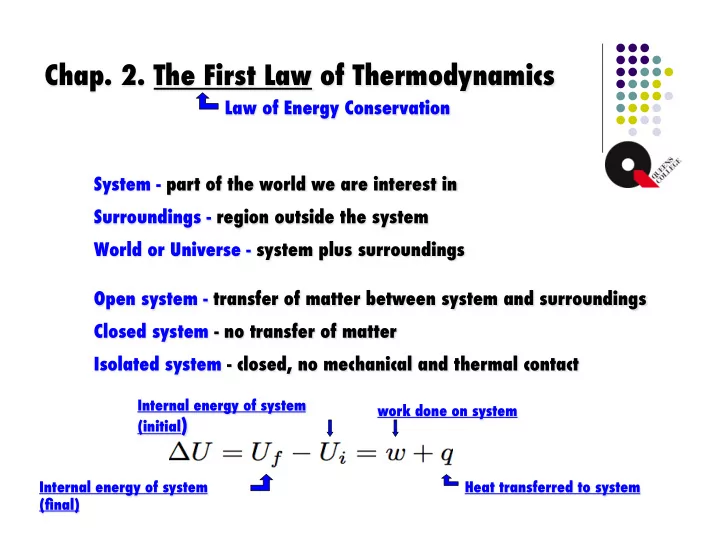

Chap. 2. The First Law of Thermodynamics � Law of Energy Conservation � System - part of the world we are interest in � Surroundings - region outside the system � World or Universe - system plus surroundings � Open system - transfer of matter between system and surroundings � Closed system - no transfer of matter � Isolated system - closed, no mechanical and thermal contact � Internal energy of system work done on system � (initial ) � Internal energy of system Heat transferred to system � (final) �
First law holds however small the heat and work are. � Infinitesimal changes: � work on system due to expansion or contraction � electric or other work on system �
First law holds however small the heat and work are. � Infinitesimal changes: � work on system due to expansion or contraction � electric or other work on system � At constant volume, � Heat capacity at constant volume - the amount of heat transferred to the system per unit increase of temperature �
First law holds however small the heat and work are. � Infinitesimal changes: � work due to expansion or contraction � electric or other work � At constant volume, � Heat capacity at constant volume - the amount of heat transferred to the system per unit increase of temperature �
Most processes occur at constant pressure. What is the relation between heat absorbed at constant pressure and the energy? � Enthalpy: � heat content, a state function in the unit of energy �
The heat absorbed at constant pressure is the same as enthalpy change of the system given that its pressure is the same as the external pressure. � Enthalpy: � heat content, a state function in the unit of energy �
The heat absorbed at constant pressure is the same as enthalpy change of the system given that its pressure is the same as the external pressure. � Enthalpy: � heat content, a state function in the unit of energy � At constant pressure, � Heat capacity at constant pressure - the amount of heat transferred to the system per unit increase of temperature �
and � are functions of temperature in general � Molar Heat Capacities �
and � are functions of temperature in general � Molar Heat Capacities � Heat capacities can be used to determine U and H � Molar energy � Molar enthalpy �
Example, Ideal Gas � Nonlinear molecule � Monoatomic � Linear molecule �
Example, Ideal Gas � Nonlinear molecule � Monoatomic � Linear molecule �
Example, Ideal Gas � Nonlinear molecule � Monoatomic � Linear molecule �
Example, Ideal Gas � Nonlinear molecule � Monoatomic � Linear molecule �
Example, Ideal Gas � Nonlinear molecule � Monoatomic � Linear molecule �
General Relations � Consider � as a function of T and V � A state function having the unit of pressure (named as internal pressure in Atkins) �
General Relations � Consider � as a function of T and V � A state function having the unit of pressure (named as internal pressure in Atkins) � Then, consider � and � as functions of T and p � (isobaric) expansion coefficient �
General Relations � Consider � as a function of T and V � A state function having the unit of pressure (named as internal pressure in Atkins) � Then, consider � and � as functions of T and p � (isobaric) expansion coefficient �
Another general relations � Consider temperature, � , as a function of H and p �
Another general relations � Consider temperature, � , as a function of H and p � (1) � Take partial derivative of (1) with (2) � respect to T while H remains fixed �
Another general relations � Consider temperature, � , as a function of H and p � (1) � Take partial derivative of (1) with (2) � respect to T while H remains fixed � Take partial derivative of (1) with respect to H while T remains fixed � Joule-Thompson (2) � coefficient �
Joule-Thompson Effect - Cooling of gas upon lowering of pressure at constant enthalpy (isenthalpic process) � Consider enthalpy, � , as a function of T and p � Isothermal Joule- Thompson coefficient � Easier to measure �
Thermochemistry � Application of thermodynamics to chemical reaction. � The set of reactants and the set of products are viewed as the same system at different physical and chemical conditions. � Phase, structure, etc � Different molecules and complexes � Standard state � Pure form at 1 bar. � Defined at any temperature, � but refers to 298.15 K if not stated explicitly. � Standard enthalpy change � Change in enthalpy for a process in which the initial and final states are in their standard states � See Table 2.4 �
� � Hess ’ s Law � The standard enthalpy of an overall reaction is the sum of the standard enthalpies of the individual reactions into which a reaction may be divided. � Direct result of enthalpy as a state function. � If � and � then � Kirchhoff ’ s law � at constant pressure � Reaction heat capacity � for the chemical reaction �
Recommend
More recommend